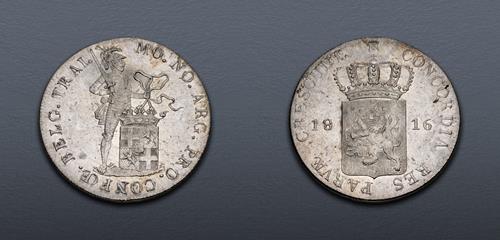
|
NETHERLANDS, Trade Coinage. temp. William I. 1815-1840. AR Rijksdaaler – Ducat (40mm, 28.15 g, 12h). Utrecht mint; mm: shield. Dated 1816.
Triton XXV
Lot: 1222. Estimated: $ 5 000
World, Silver
Sold For $ 9 500. This amount does not include the buyer’s fee.
Go to Live
|
|
NETHERLANDS, Trade Coinage. temp. William I. 1815-1840. AR Rijksdaaler – Ducat (40mm, 28.15 g, 12h). Utrecht mint; mm: shield. Dated 1816. Soldier standing right, holding sword and crowned coat-of-arms by ribbon / Crowned coat-of-arms. Schulman 235; KM 46; Davenport 225. Light toning over frosty surfaces. UNC. Formerly in NGC encapsulation graded MS 63. Extremely rare two year type. Seldom offered in this condition. This coin is finest in CoinArchives.
From the J. de Wilde Collection. Ex Richard L. Lissner Collection (St. James’s 29, 1 August 2014), lot 696, purchased from Jacques Schulman, April 1978.
The term trade coinage refers to those precious metal issues that were minted by a particular government for the purpose of trade beyond the boundaries of the issuing state. Because these issues were of a recognized fineness, they were employed as quasi-bullion to make large-scale purchases of goods and raw materials in countries where such transactions allowed for a greater value of goods and raw materials to be purchased. Trade coinage was particularly popular in Africa, the Middle East, and South East Asia where certain European coins continued to circulate there long after they were withdrawn from circulation in the home country.
Like the Venetian and Hungarian ducats, the Netherlands ducat (and, later, the rijksdaaler) became a recognized trade coinage. Beginning in the late fifteenth century under Philip the Fair, the Low Countries began issuing gold ducats of a set weight and fineness, a standard that continued unchanged until the twentieth century. While earlier ducats derived their designs from the Spanish excelente, in 1586, the Dutch introduced what would become the standard design for all their trade coinage. Taking their inspiration from the then current Hungarian ducat, the Dutch modified the design to reflect their political aspirations that were then on the rise during the Eighty Years' War (1568-1648). Furthermore, because the Dutch East India Company was at that same time in its infancy, this gold and silver trade coinage was widely recognized and accepted as far away as Asia and the Americas, thereby facilitating the expansion of the great Dutch overseas empire. Long after both the Dutch East India Company and the Kingdom of the Netherlands issued their own coinages, this Dutch trade coinage was still being minted – a symbol of economic stability and the long-standing influence of one of the world's great international economic empires.
The final winners of all Triton XXV lots will be determined at the live public sale that will be held on 11-12 January 2022. Triton XXV – Session Four – Early Medieval & Islamic Coinage through Large Lots will be held Wednesday afternoon, 12 January 2022 beginning at 2:00 PM ET.
Winning bids are subject to a 20% buyer's fee for bids placed on this website and 22.50% for all others.
We recognize that our users may have various Internet Browsers and Operating Systems. We like our visitors to have the best possible experience when using our bidding platform. However, we do recognize that it is impossible to develop applications that work identically, efficiently and effectively on all web browsers. The CNG bidding platform supports the latest stable major version and the stable previous version of Mozilla Firefox and Chrome.
|
